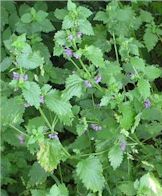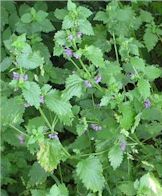|

Horehound |
The herb Horehound occurs of two sorts, white and black, in our hedge-rows, and on the sides of banks, each getting its generic name, which was originally harehune, from hara, hoary, and hune, honey; or, possibly, the name horehound may be a corruption of the Latin urinaria, since the herb has been found efficacious in cases of strangury, or difficult making of water.
The white horehound (Marrubium) is a common square-stemmed herb of the labiate order, growing in waste places, and of popular use for coughs and colds, whether in a medicinal form, or as a candied sweetmeat. Its botanical title is of Hebrew derivation, from marrob, a |
bitter juice. The plant is distinguished by the white woolly down on its stems, by its wrinkled leaves, and small white flowers.
It has a musky odor, and a bitter taste, being a much esteemed herbal simple, but very often spuriously imitated. It affords chemically a fragrant volatile oil, a bitter extractive "marrubin," and gallic acid.
As a homely remedy it is especially given for coughs accompanied with abundant thick expectoration, and for chronic asthma. In Norfolk scarcely a cottage garden can be found without its horehound corner; and horehound beer is much drunk there by the natives. Horehound tea may be made by pouring boiling water on the fresh leaves, an ounce to a pint, and sweetening this with honey: then a wineglassful should be taken three or four times in the day. Or from two to three
teaspoonfuls of the expressed juice of the herb may be given for a dose.
Candied horehound is best made from the fresh plant by boiling it down until the juice is extracted, and then adding sugar before boiling this again until it has become thick enough of consistence to pour into a paper case, and to be cut into squares when cool. Gerard said: "syrup made from the greene fresh leaves and sugar is a most singular remedy against the cough and wheezing of the lungs. It doth wonderfully, and above credit, ease such as have been long sicke of any
consumption of the lungs; as hath been often proved by the learned physicians of our London college."
When given in full doses, an infusion of the herb is laxative. If the plant be put in new milk and set in a place pestered with flies, it will speedily kill them all. And according to columella, the horehound is a serviceable remedy against the cankerworm in trees: profuit et plantis latices infundere amaros marrubii.
The Marrubium was called by the Egyptian priests the "seed of horus" or "the bull's blood" and "the eye of the star." It was a principal remedy in the negro Caesar's antidote for vegetable poisons.
|

Black Horehound |
The Black Horehound (Ballota nigra), so called from its dark purple-colored flowers, is likewise of common growth about our roadsides and waste places. Its botanical title comes from the Greek ballo, to reject, because of its disagreeable odor, particularly when burnt. The herb is sometimes known as madwort, being supposed to act as an antidote to the bite of a mad dog. In beaumont and fletcher's
faithful shepherdess, we read of:
"Black Horehound, good for sheep, or shepherd bitten by a wood-dog's venomed tooth."
|
If its leaves are applied externally as a poultice, they will relieve the pain of gout, and will mollify angry boils. In Gotha the plant is valued for curing chronic skin diseases, particularly of a fungoid character, such as ringworm; also for diseases of cattle. "This," says Meyrick "is one of those neglected English herbs which are possessed of great virtues, though they are but little known, and still less regarded. It is superior to most things as a remedy in hysteria,
and for low spirits." Drayton said (Polybion, 1613):
"For comforting the spleen and liver--get for juice, pale horehound."
The Water Horehound (Lycopus), or gipsy wort, which grows frequently in our damp meadows and on the sides of streams, yields a black dye used for wool, or silk, and with which gypsies stain their skins, as well as with walnut juice. "This is called gipsy wort," says lyte, "because the rogues and runagates, which name themselves Egyptians, do color themselves black with this herbe." Each of the horehounds is a labiate plant; and this, the water variety, bears flesh colored
flowers, whilst containing a volatile oil, a resin, a bitter principle, and tannin. Its medicinal action is astringent, with a reduced frequency of the pulse, and some gentle sedative effects, so that any tendency to coughing, etc., will be allayed. Half-an-ounce of the plant to a pint of boiling water will make the infusion.
Herb Simples
The Primitive Simplers presented here show the way of life in other generations, it is not suggested or recommended trying them yourself. |
|
Garden
Herbs
Home
History of Herbs
Herb Gardening
Herbs for Beginners
Drying & Preserving Herbs
Indoor Herb Gardening
Herb Garden
Hints & Tips
Herbal
Cooking
Herb Chart
Using Herbs
Culinary Herbs
Herb
Oil and Vinegar
Herb Teas
Herb Candy
Herb Jelly
Herb Simples
Preface
Introduction
Alphabetical Listing

Trade
Recipes Online
Share your Recipes with others!!
|



